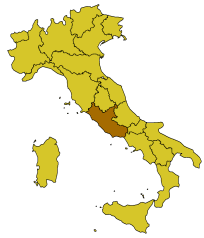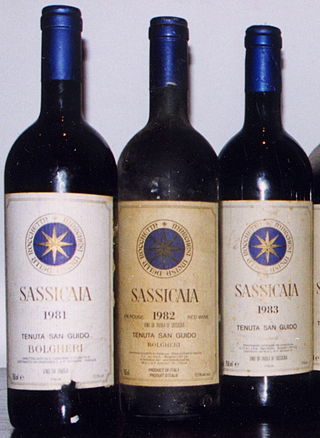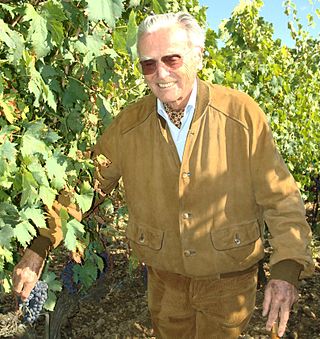Related Research Articles

Chianti is an Italian red wine produced in the Chianti region of central Tuscany, principally from the Sangiovese grape. It was historically associated with a squat bottle enclosed in a straw basket, called a fiasco. However, the fiasco is now only used by a few makers of the wine; most Chianti is bottled in more standard-shaped wine bottles. In the latter nineteenth century, Baron Bettino Ricasoli helped establish Sangiovese as the blend's dominant grape variety, creating the blueprint for today's Chianti wines.

Montalcino is a hill town and comune in the province of Siena, Tuscany, central Italy.

Sangiovese is a red Italian wine grape variety that derives its name from the Latin sanguis Jovis, "blood of Jupiter".

Brunello di Montalcino is a red DOCG Italian wine produced in the vineyards surrounding the town of Montalcino, in the province of Siena, located about 80 km south of Florence, in the Tuscan wine region. Brunello, a diminutive of bruno, is the name that was given locally to what was believed to be an individual grape variety grown in Montalcino. In 1879 the province of Siena's Amphelographic Commission determined, after a few years of controlled experiments, that Sangiovese and Brunello were the same grape variety, and that the former should be its designated name. In Montalcino the name Brunello evolved into the designation of the wine produced with 100% Sangiovese.

Marchesi Antinori Srl is an Italian wine company, based in Florence, Tuscany, that can trace its history back to 1385. They are one of the biggest wine companies in Italy, and their innovations played a large part in the "Super-Tuscan" revolution of the 1970s.

The Val d'Orcia or Valdorcia is a region of Tuscany, central Italy, which extends from the hills south of Siena to Monte Amiata. Its gentle, cultivated hills are occasionally broken by gullies and by towns and villages such as Pienza, Radicofani and Montalcino. Its landscape has been depicted in works of art from Renaissance painting to modern photography.

Cesanese Comune is a red Italian wine grape variety that is grown primarily in the Lazio region. The grape has three Denominazione di origine controllata (DOC) regions dedicated to it-Cesanese di Affile DOC, Cesanese di Olevano DOC and Cesanese di Piglio DOC. Cesanese di Affile appears to be a distinct sub-variety of Cesanese Comune unique to the commune of Affile. There are noticeable differences between Cesanese Comune and the grapes found in Cesanese di Affile, including the size of the grape berry itself. The sub-variety Cesanese d'Affile is considered to be of superior quality of Cesanese Comune and is used as minor ingredient in the Tuscan cult wine Trinoro. The grape has very old origins, and may have been used in Roman winemaking. Today it is rarely seen outside of the Lazio.
John Radford, born in Nottingham on 1 December 1946, died on 19 October 2012, was a British writer and broadcaster in the field of wine and food, with an emphasis on Spain. He was educated at Stamford School in Lincolnshire.

Tuscan wine is Italian wine from the Tuscany region. Located in central Italy along the Tyrrhenian coast, Tuscany is home to some of the world's most notable wine regions. Chianti, Brunello di Montalcino and Vino Nobile di Montepulciano are primarily made with Sangiovese grape whereas the Vernaccia grape is the basis of the white Vernaccia di San Gimignano. Tuscany is also known for the dessert wine Vin Santo, made from a variety of the region's grapes. Tuscany has forty-one Denominazioni di origine controllata (DOC) and eleven Denominazioni di Origine Controllata e Garantita (DOCG). In the 1970s a new class of wines known in the trade as "Super Tuscans" emerged. These wines were made outside DOC/DOCG regulations but were considered of high quality and commanded high prices. Many of these wines became cult wines. In the reformation of the Italian classification system many of the original Super Tuscans now qualify as DOC or DOCG wines but some producers still prefer the declassified rankings or to use the Indicazione Geografica Tipica (IGT) classification of Toscana. Tuscany has six sub-categories of IGT wines today.

Tenuta San Guido is an Italian wine producer in the DOC Bolgheri in Toscana, known as a producer of "Super Tuscan" wine. It produces Sassicaia, a Bordeaux-style red wine. The estate also produces a second wine, Guidalberto, and a third wine, Le Difese. Tenuta San Guido is member of the Primum Familiae Vini.

Brunellopoli is the name given by Italian press for a scandal involving producers of Brunello di Montalcino under suspicion of wine fraud, first reported by Italian wine journalist Franco Ziliani and American wine critic James Suckling of Wine Spectator. The name "Brunellopoli" bears reference to Tangentopoli, or Bribesville, the Italian political scandal of the 1990s, while some English language reporters have applied the name "Brunellogate".

Nicolas Belfrage MW was a British Master of Wine, a wine writer and considered one of the foremost experts on Italian wine.

Bolgheri is a central Italian village and hamlet (frazione) of Castagneto Carducci, a municipality (comune) in the province of Livorno, Tuscany. in 2011 it had a population of 131.
Fiorano was an Italian wine-producing estate owned by Alberico Boncompagni Ludovisi, a prince of Venosa of the Ludovisi family, active during a period from the late 1940s to 1995. Fiorano is situated in the vicinity of Rome near the Via Appia Antica in the Latium district. Famed wine writer Burton Anderson dubbed Fiorano's wines 'the noblest Romans of them all' in his 1980 anthology Vino. The estate, its methods, wines and its proprietor were all noted for their unorthodoxy in comparison to norms of the wine industry. Though limited in terms of fame, the red wine and two white wines produced at Fiorano during its period of activity achieved reputations for innovation and longevity. Since the late 1960s a small number of devout 'cognoscenti', especially among restaurant owners in Rome, knew about the extraordinary qualities of the two whites Fiorano Bianco and Fiorano Riserva Semillon, and overcame numerous obstacles in order to get the wines.

Azienda Agricola Case Basse di Gianfranco Soldera, commonly referred to as Case Basse or Soldera, is an Italian wine producer located in Montalcino, Tuscany, producing highly priced wine declared under DOCG Brunello di Montalcino. It was owned by Gianfranco Soldera from 1972 until his death on February 16, 2019, at age 82.

Franco Biondi Santi was an Italian winemaker, most known for producing Brunello di Montalcino, a red wine produced only in Montalcino, Tuscany.

Kerin O'Keefe is a wine critic specialized in Italian wine and author of four books. She reviews wines and writes articles on the growing areas, wines and producers for kerinokeefe.com.
Countess Noemi Marone Cinzano is an Italian businessperson. A wine personality, she is known for owning many well established vineyards and Cinzano Glass. Her flagship wine is considered to be Noemía de Patagonia.
Moscadello di Montalcino is a white Italian wine from the Tuscan wine village of Montalcino.
References
- 1 2 3 Hall of Fame inductees 2007 http://winemediaguild.org/?page_id=12 Wine Media Guild, June 16, 2012
- 1 2 3 Apple Jr., R.W. (24 April 1994). "Mangia!". The New York Times .
- ↑ O'Keefe, Kerin. Franco Biondi Santi. The gentleman of Brunello, Veronelli Editore, 2005, ISBN 8872501156
- ↑ Experts on Italian wine honored, The Free Library
- ↑ Past Winners André Simon Memorial Fund Award, http://www.andresimon.co.uk/past.html
- ↑ Glennfiddich Award 1972-2003 "Glenfiddich Award for Best Drink Book". Archived from the original on 2015-01-25. Retrieved 2013-12-16.
- 1 2 James Beard Awards, James Beard Awards for Food + Wine & Spirits
- ↑ Kramer, Matt (19 February 1997). "Where the Wine Is". Los Angeles Times .
- ↑ Anderson, Lisa (17 May 1995). "Year Of Eating Well". Chicago Tribune .